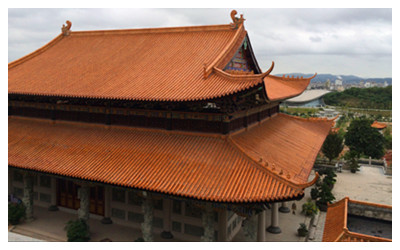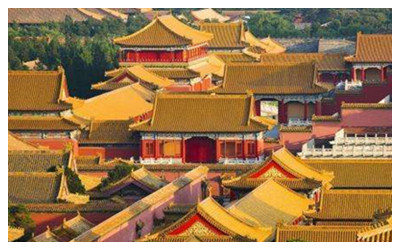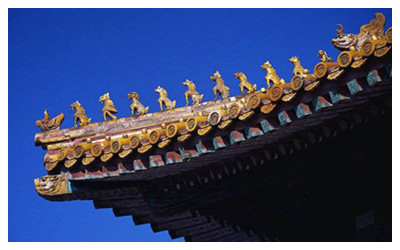
Even though it may not seem like roofs are an important part of Chinese architecture, they are very important. Roofs did not only protect residences from the elements, they also had a deeper meaning. The arc at which the roof turns comes from the intricate fit of rafters. They used rods of short rafters that melt together Even wealthy homes had elaborate roofs.
Ancient Chinese artisans ingeniously made the heavy roofs of buildings look light and graceful by forming the ridges and eaves into curves, and making the four corners stick up. The style of a roof can be divided into four basic types: fudian(wings), xieshan(hip and gable), xuanshan(hard gable), which denote a roof with a single layer, several layers, four corners and many corners. All these make the huge roof an important component of ancient Chinese architecture with an outstanding artistic image.
In order to impart lightness and grace to pillars, the diameters of the upper ends or both ends of upright pillars are slightly reduced, making them look like weaving shuttles. Beneath the pillars, stone foundations are needed to prevent humidity from underground eroding the wooden pillars. The foundations are often carved with
decorative patterns. With the same purpose in mind, the two ends of the beams and crossbeams are given downward-pointing curves, giving them the shape of a crescent moon; thus they are called "crescent roof beams." The protruding parts of the roof beams are carved into various, such as branches and leaves,and geometric figures.
The decorations on ancient Chinese structures have cultural connotations as well as esthetic ones. The dragon heads on the edges of roof ridges signigy the spurting of water to douse fires. The dragon, phoenix, tiger and tortoise were regarded as sacred animals by the ancient Chinese, and they carved images of them on eave tiles which were exclusively used on imperial structures. The emperors were supposed to be descendants of dragons, so there are images of dragons all over imperial structures, from balustrade column heads, terrace steps and stone foundations of pillars to roof beams, paintings on ceilings and carvings on doors and windows. Symbols denoting happiness, honor and longevity can be seen everywhere on traditional Chinese structures, including palaces, temples, gardens, residences, gateways, windows and roof beams. Bats represent happiness, deer stand for honor, and pines, cranes and peaches represent longevity. In addition, there are various pattterns made by putting Chinese characters together, like the combination of the characters meaning happiness, longevity and ten thousand.

One perfect example of splendid roofs would be located inside the wonderful palace- the Forbidden City. The ridges of each roof carries figurines and/or mythical creatures. The curve of each roof can be no more than a sweep and the most intricate designs on the roof are almost always pointing south-east. However, there are some down sides to having all of these decorations of the roof. The tremendous weight could eventually bring down the entire complex. That is why the Chinese have added an additional colonnade to support the weight under the outer edges, reducing the bracket system to mere decorations. The brackets are decorated by elaborately painting them with bright colors and eye-popping designs.

 Even though it may not seem like roofs are an important part of Chinese architecture, they are very important. Roofs did not only protect residences from the elements, they also had a deeper meaning. The arc at which the roof turns comes from the intricate fit of rafters. They used rods of short rafters that melt together Even wealthy homes had elaborate roofs.
Even though it may not seem like roofs are an important part of Chinese architecture, they are very important. Roofs did not only protect residences from the elements, they also had a deeper meaning. The arc at which the roof turns comes from the intricate fit of rafters. They used rods of short rafters that melt together Even wealthy homes had elaborate roofs.
 One perfect example of splendid roofs would be located inside the wonderful palace- the Forbidden City. The ridges of each roof carries figurines and/or mythical creatures. The curve of each roof can be no more than a sweep and the most intricate designs on the roof are almost always pointing south-east. However, there are some down sides to having all of these decorations of the roof. The tremendous weight could eventually bring down the entire complex. That is why the Chinese have added an additional colonnade to support the weight under the outer edges, reducing the bracket system to mere decorations. The brackets are decorated by elaborately painting them with bright colors and eye-popping designs.
One perfect example of splendid roofs would be located inside the wonderful palace- the Forbidden City. The ridges of each roof carries figurines and/or mythical creatures. The curve of each roof can be no more than a sweep and the most intricate designs on the roof are almost always pointing south-east. However, there are some down sides to having all of these decorations of the roof. The tremendous weight could eventually bring down the entire complex. That is why the Chinese have added an additional colonnade to support the weight under the outer edges, reducing the bracket system to mere decorations. The brackets are decorated by elaborately painting them with bright colors and eye-popping designs. Ask Questions ?
Ask Questions ?